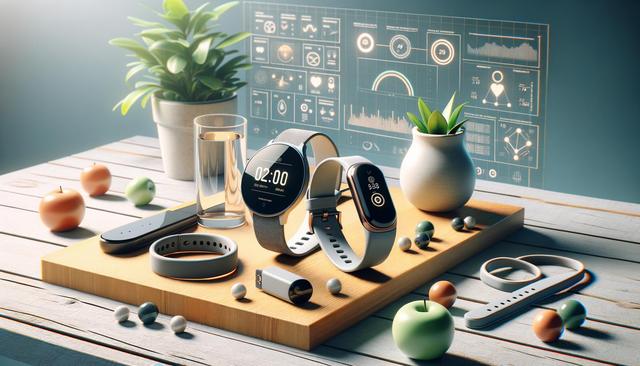The Rise of Smart Wearables in Everyday Life
Technology continues to evolve at a rapid pace, and smart wearables have emerged as one of the most impactful innovations in recent years. These devices, which include smartwatches, fitness bands, and even smart rings, are designed to offer users real-time insights into their physical activity, health metrics, and even sleep patterns. What makes smart wearables particularly significant is their seamless integration into daily life. Unlike traditional health monitoring tools, wearables are non-intrusive and provide continual feedback without requiring active input from the user. This level of convenience makes them appealing to a broad audience—from fitness enthusiasts to busy professionals looking to maintain a balanced lifestyle.
As more people seek ways to stay informed about their bodies and habits, smart wearables offer a practical solution. These devices are often equipped with sensors that monitor heart rate, steps taken, distance traveled, and calories burned. Some advanced models go even further, tracking blood oxygen levels, skin temperature, and stress levels through heart rate variability. This kind of data empowers users to make informed choices about their health and wellness goals.
Health Monitoring at Your Fingertips
One of the most valued features of smart wearables is their ability to monitor health consistently and accurately. For individuals managing chronic conditions like hypertension or diabetes, these devices can provide essential data that helps both users and healthcare providers make timely decisions. For example, continuous heart rate monitoring can detect irregular patterns that may signal a health issue long before symptoms appear.
Wearables are also proving useful in preventive healthcare. By tracking activity levels and sleep quality, users can identify behavioral patterns that might contribute to fatigue or stress. This information can encourage changes such as improved sleep hygiene or increased physical activity. Some devices even offer guided breathing exercises to help manage stress in real time.
Key health metrics often tracked include:
- Resting and active heart rate
- Blood oxygen saturation (SpO2)
- Sleep stages (light, deep, REM)
- Stress indicators
- Respiratory rate
These capabilities are contributing to a shift in how people approach their health—from reactive to proactive management.
Enhancing Productivity and Daily Habits
While health tracking is a major benefit, smart wearables are also enhancing productivity and supporting better daily habits. Many wearables come with features such as calendar alerts, reminders, and even voice assistants, all of which help users stay organized and focused. With gentle nudges to stand up after long periods of inactivity or reminders to drink water, these devices help promote healthier routines throughout the day.
For those working remotely or in hybrid environments, wearables can be incredibly useful in maintaining structure. They can serve as gentle accountability tools, prompting users to take regular breaks or log physical activity. Some wearables also offer goal-setting features, enabling users to track progress toward daily, weekly, or monthly targets.
Features that support productivity include:
- Silent alarms and reminders
- Calendar synchronization
- Time management analytics
- Customizable notifications
These tools can help users strike a balance between work and personal well-being, encouraging a more mindful approach to time and energy management.
Integration with Broader Ecosystems
Another strength of smart wearables is their ability to integrate with other devices and platforms. Many wearables sync with smartphones, cloud services, and even smart home systems, creating a cohesive digital ecosystem. This integration enhances the functionality of the device by providing deeper insights and more nuanced data analysis through companion apps and software.
For instance, syncing a wearable with a nutrition tracking app allows users to cross-reference their physical activity with their dietary intake. Similarly, integration with home fitness equipment can provide a more complete picture of one’s workout performance. These connections create a more personalized experience, allowing users to tailor their health and fitness plans based on real-time data.
Popular integrations include:
- Mobile health apps for diet and hydration tracking
- Virtual coaching platforms
- Smart scales and blood pressure monitors
- Smart home devices (e.g., lights, thermostats)
Such integrations make smart wearables more than just standalone gadgets—they become central components in a broader health and lifestyle management system.
Challenges and Future Outlook
Despite their growing popularity, smart wearables face certain challenges that may impact their adoption and effectiveness. Privacy and data security are at the forefront of these concerns. As wearables collect sensitive health information, it’s essential that manufacturers implement strong encryption and transparent data policies to protect users. Another challenge lies in accuracy. While wearable technology has improved significantly, discrepancies in data accuracy still exist, especially when compared to medical-grade equipment.
Battery life and device compatibility are also common user concerns. Frequent charging can be inconvenient, especially for devices intended to monitor sleep. Additionally, not all wearables are compatible with every operating system or third-party app, limiting their usefulness for some users.
Looking ahead, the future of smart wearables appears promising. Advances in sensor technology, artificial intelligence, and data analytics will likely lead to even more sophisticated devices capable of diagnosing conditions, offering real-time health advice, and adapting to individual behavior patterns. As the technology matures, we can expect wearables to play an increasingly central role in personal healthcare and wellness management.
Conclusion: Embracing a Smarter Lifestyle
Smart wearables are quickly becoming essential tools for individuals seeking to take control of their health, productivity, and daily routines. By offering real-time insights and seamless integration into digital ecosystems, these devices support a proactive and informed approach to personal well-being. While challenges remain, ongoing advancements suggest that smart wearables will continue to evolve, offering even greater value to users. For anyone looking to cultivate healthier habits and stay connected with their personal goals, smart wearables present a practical and forward-thinking solution.







